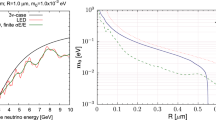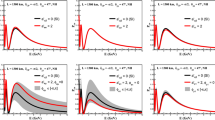Abstract
We consider the four neutrino oscillation that accommodate the all neutrino oscillation data. We consider the range of the corresponding mixing parameters by the result of neutrino oscillation experiments. Implicaion of the neutrino oscillation search for the neutrino mass square difference and mixing are discussed. We determine the possible values of the effective majorana neutrino mass \(|<m>|=|{\sum }_{j}U_{ej}^{2}m_{j}|\) in the four neutrino scenario. In the four-neutrino scheme there is an upper bound on | < m > | of the normal mass order is 2.0074eV for α = 0∘,β = 0∘andγ = 0∘. In the case of inverted mass order the upper bound on | < m > | is 2.0069eV for α = 0∘,β = 0∘andγ = 0∘.
Similar content being viewed by others
Avoid common mistakes on your manuscript.
1 Introduction
The phenomenon of neutrino oscillation, impressive advance have been made to understand the phenomenology of neutrino oscillation through solar neutrino,atmospheric neutrino,reactor neutrino and accelerator neutrino experiment. The experimental research on the nature of neutrinos through terrestrial as well as extra-terrestrial approaches has finally confirmed the neutrino oscillation in atmospheric [1,2,3,4,5,6,7] solar [8,9,10,11,12,13,14], reactor [15,16,17] and accelerator [18, 19] neutrino sources, establishing that neutrinos have mass. Furthermore, it is generally agreed that oscillations among three neutrino species are sufficient to explain the atmospheric, solar, reactor and accelerator neutrino puzzle. The neutrino oscillation experiments provide us with neutrino mass square differences, mixing angles and a possible hierarchy in the neutrino mass spectrum. The main physical goal in future experiment are the determination of the unknown parameter 𝜃13. In particular, the observation of δ is quite interesting from the point of view that δ is related to the origin of the matter in the universe. One of the most important parameter in neutrino physics is the magnitude of mixing angle 𝜃13 and CP phase δ. The oscillation data also suggests that the neutrinos may belong to either a normal hierarchy (m1 < m2 < m3) or an inverted hierarchy (m3 < m1 < m2). The data do not exclude the possibility that the mass of the light neutrino could be much larger than \(\sqrt {\boldsymbol {\bigtriangleup }_{31}}\), which would imply the possible existence of a quasi-degenerate neutrino mass spectrum (m1 ≈ m2 ≈ m3). On the other hand, the actual mass of neutrinos cannot be extracted from these data, only the study of tritium single β decay and nuclear double beta decay together can provide sharpest limits on the mass and nature of neutrinos. Neutrino oscillations, which only depend on mass square difference, give no information about the absolute value of the neutrino mass squared eigenvalues. Hence, there are various possibilities of neutrino hierarchy spectrums consistent with solar and atmospheric neutrino oscillation data. The mass eigenstates with eigen values mi can be determined if the absolute value of effective mass of neutrino is exactly known. The current neutrinoless double beta decay experiments only provide the upper limit on effective Majorana neutrino mass < mee > so that absolute scale of neutrino mass is not determined yet. Therefore, in the present work we have attempted to present a effective neutrino neutrino mass in the case of normal and inverted neutrino mass order.
In this paper, we will discuss the effective neutrino masses for different neutrino mass spectrum, namely normal mass hierarchy (m1 < m2 < m3), inverted mass hierarchy (m3 < m1 < m2). The present work is organized as follows. In Section 2, we outline the neutrino oscillation parameters. In Section 3, we have given the theoretical formalism to calculate the effective neutrino masses above mentioned hierarchies. In Section 4, we present the numerical results and Section 5 is devoted to the conclusions.
2 Mixing Angles and Neutrino Mass Squared Differences
The first evidence is the observation of zenith-angle dependence of atmospheric neutrino defect [20] dependent of the atmospheric neutrino \(\nu _{\mu }\rightarrow \nu _{\mu }\) transition with the mass difference and the mixing as
From the recent three neutrino analysis of the Super-Kamiokande data [29] the following 90% CL were found for the normal (inverted) neutrino mass spectrum
The second evidence is the solar neutrino deficit [21], which is consistent with \(\nu _{\mu }\rightarrow \nu _{\tau }/\nu _{e}\) transition. The SNO experiments [22] are consistent with the standard solar model [23] and strongly suggest the LMA solution.
Solar neutrino experiments (Super-K, GALLEX, SAGE, SNO and GNO) show the neutrino oscillations, neutrino oscillation provide the most elegant explanation of all the data [24].
From the three neutrino global analysis of the solar and reactor KamLAND data was found [27],
Atmospheric neutrino experiments (Kamiokande, Super-K) also show the neutrino oscillation. The most excellent fit to the all data [24].
The CHOOZ reactor experiment [25] gives the upper bound on the third mixing angle 𝜃13 as
at the 90% CL. The CP phase δ has not been constrained. From the two neutrino analysis of the MINOS data obtained was [26],
The future neutrino experiments plan to measure the oscillation parameters precisely. The combined analysis of Day Bay, MINOS and Bugey-3 data [28] has excluded most of the parameter space of the mass squared difference \({\Delta }_{41}={m_{4}^{2}}-{m_{i}^{2}}\) and the mixing angle sin2𝜃14 for the sterile neutrino, the latest global analysis of neutrino oscillation data indicates that a small region arround the best-fit value of [29]
3 Effective Majorona Mass of Electron Neutrino
In the presence of one sterile neutrino, in four flavour neutrino mixing the electron neutrino is combination of mass eigenstate, νi with eigenvalue mi
Here Uei are the elements of the 4 × 4 mixing matrix,which relates the flavour states the the mass eigenstates. The ββ0ν decay rate is determined by the effective Majorana mass of the electron neutrino mee. Under the assumption of four flavour neutrino mixing of neutrino, the effective Majorana neutrino mass mee [30] is B
We consider that the sterile neutrino with mass m4is heavier than light active neutrinos. Therefore, the effective Majorana mass in case of normal ordering of active neutrino is given as
Similarly for the case of inverted hierarchy of active neutrinos, the expression in (15) can be rewritten as
The PMNS matrix U4×4 depends on the mixing angles and CP violating phases. Using the parameterization in (13)
where the matrices Rijare rotations in ij space,
where sij = sin𝜃ij,cij = cos𝜃ij. The diagonal matrix P contains the three Majorana phases α,βandγ :
Note that there are in total three Dirac CP-violating phase δij. P is constructed in such a way that only Majorana phases show up in the effective mass expression.
4 Numerical Results
Note from (16) and (17) that the effective neutrino depends on new physics involving sterile neutrino mixing angle 𝜃14 and the mass square difference Δ41. Also cruically the type of neutrino mass spectrum, normal or inverse hierarchical spectrum. Hence, we consider a degenerated neutrino Mass spectrum and take the common neutrino mass to be 2 eV, which is upper limit of tritium beta decay spectrum [31].
In Tables 1, 2, 3, 4 and 5 for normal mass order and Tables 6, 7, 8, 9 and 10 for inverted mass order, we list the effective neutrino mass Vs majorana phases for CP phase conserved case. Using the best fit value [24,25,26, 29] of oscillation parameter. For the computational purpose, the Majorana phase are taken as α,βandγ. We have taken these values from 0 − 180 degrees.
5 Conclusions
Future and present search for neutrinoless double beta decay purpose at probing lepton number violation and the Majorona nature of neutrinos with remarkable precession. Several experimental programs is currently under discussion.
In this paper, we have explored the impact of a majorana phases α,βandγ on the effective neutrino masses. Taking the best-fit value Δ41 = 1.7eV2andsin2𝜃14 = 0.019. We find the effective neutrino mass mee, for normal neutrino mass order is \(m_{ee}^{upper-limit}=2.0074eV for \alpha =0^{\circ },\beta =0^{\circ } and \gamma =0^{\circ }\) and \(m_{ee}^{lower-limit}=0.6083eV for \alpha =180^{\circ },\beta =180^{\circ } and \gamma =180^{\circ }\). The effective neutrino mass mee, for inverted neutrino mass order is \(m_{ee}^{upper-limit}=2.0069eV for \alpha =0^{\circ },\beta =0^{\circ } and \gamma =0^{\circ }\)and \(m_{ee}^{lower-limit}=0.6081eV for \alpha =180^{\circ },\beta =180^{\circ } and \gamma =180^{\circ }\). We have found due to nonzero value of majorona phases, effective neutrino masses supresses.
References
Super Kamiokande Collaboration, Wendell, R, et al.: Phys. Rev. D 81, 092004 (2010)
Super-Kamiokande Collaboration, Ashie, Y., et al.: Phys. Rev. D 71, 112005 (2005)
Super-Kamiokande Collaboration, Fukuda, Y., et al.: Phys. Rev. Lett. 82, 1810 (1999)
Super-Kamiokande Collaboration, Fukuda, Y., et al.: Phys. Rev. Lett. 82, 2430 (1999)
Super-Kamiokande Collaboration, Fukuda, Y., et al.: Phys. Rev. Lett. 82, 2644 (1999)
Super-Kamiokande Collaboration, Fukuda, Y., et al.: Phys. Rev. lett. 81, 1562 (1998)
Macro Collaboration, Surdo, A., et al.: Nucl. Phys. Proc. Suppl. 110, 342 (2002)
Soudan Collaboration, Sanchez, M., et al.: Phys. Rev. D 68, 113004 (2003)
Super Kamiokande Collaboration, Cravens, J.P., et al.: Phys. Rev.D 78, 032002 (2008)
Abe, K., et al.: arXiv:hep-ex/1010.0118
Cleveland, B.T., et al.: Astrophys. J 496, 505 (1998)
Cattadori, C., Ferrari, N., Pandola, L.: Nucl. Phys. B (Proc. Suppl.) 143, 3 (2005)
Super-Kamiokande Collaboration, Fukuda, Y., et al.: Phys. Lett. B539, 179 (2002)
Super-Kamiokande Collaboration, Fukuda, Y., et al.: Phys. Rev. D 73, 112001 (2006)
SNO Collaboration, Ahmad, Q.R., et al.: Phys. Rev. Lett. 89, 011301 (2002)
Gando, A., et al.: arXiv:hep-ex/1009.4771
KamLand Collaboration, Eguchi, K., et al.: Phys. Rev. Lett. 90, 021802 (2003). arXiv:hep-ex/0212021
KamLand Collaboration, Araki, T., et al.: Phys. Rev. Lett. 94, 081801 (2005)
K2K Collaboration, Aliu, E., et al.: Phy. Rev. Lett. 94, 081802 (2005)
Super-Kamiokande Collaboration, Ashie, Y., et al.: Phys. Rev. D 71, 112005 (2005)
Freund, M., Hunder, P., Lindner, M.: Nucl. Phys. B 615, 331–357 (2001)
Cervera, A., et al.: Nucl. Phy. B 579, 17 (2000)
Super-Kamiokande Collaboration, Fukuda, Y., et al.: Phys. Rev. Lett 81, 1562 (1998)
Hampel, W.: Phys. Lett. B 447, 127 (1999)
CHOOZ Collaboration, Apollonio, C., et al.: Eur. Phy. J 27, 33 (2003)
MINOS Collaboration, Habig, A., et al.: Mod. Phys. Lett. A25, 1219 (2010)
KamLAND Collaboration, Gando, et al.: arXiv:1009.4771v2
Gariazzo, S., et al.: J. Phys. G 43, 033001 (2016)
Gariazzo, S., et al.: JHEP 1706, 135 (2017)
Barry, J., et al.: JHEP 1107, 091 (2011)
Kraus, C., et al.: Eur. Phys. J., 33 (2004)
Author information
Authors and Affiliations
Corresponding author
Additional information
Publisher’s Note
Springer Nature remains neutral with regard to jurisdictional claims in published maps and institutional affiliations.
Rights and permissions
Open Access This article is licensed under a Creative Commons Attribution 4.0 International License, which permits use, sharing, adaptation, distribution and reproduction in any medium or format, as long as you give appropriate credit to the original author(s) and the source, provide a link to the Creative Commons licence, and indicate if changes were made. The images or other third party material in this article are included in the article's Creative Commons licence, unless indicated otherwise in a credit line to the material. If material is not included in the article's Creative Commons licence and your intended use is not permitted by statutory regulation or exceeds the permitted use, you will need to obtain permission directly from the copyright holder. To view a copy of this licence, visit http://creativecommons.org/licenses/by/4.0/.
About this article
Cite this article
Koranga, B.S., Nautiyal, V.K. Effective Neutrino Masses from Four Flavor Neutrino Mixing Matrix. Int J Theor Phys 60, 781–792 (2021). https://doi.org/10.1007/s10773-020-04683-y
Received:
Accepted:
Published:
Issue Date:
DOI: https://doi.org/10.1007/s10773-020-04683-y




